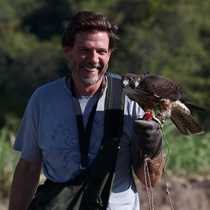The National Geographic Sea Bird was underway all night, and early this morning began making her way up the majestic Tracy Arm Fjord, part of the Tracy Arm-Ford’s Terror Wilderness System. 1,000-foot high cliff walls extend up from the sea with a depth of about the same measure. Some areas display sheer rock face, while others are covered in vegetation and trees. Ice and snow caps dot the landscape with white, and water flings itself down towards the sea in varying amounts, from pencil-thin streams to thick ribbon-like bands. The crisp fresh air carries a distinct chill, and the green-silted water floats various sizes and shapes of ice.
“Good morning… good morning everyone,” came the hushed voice of the expedition leader over the PA system. “It is 6:45, and we are waking you up a little early because we have a black bear sighted. Please, when you go out on the decks, be very quiet. Remember bears are easily scared away by human sounds. Come out onto the bow and we can point it out from there.” The bear had been spotted climbing down the steep cliff wall amongst a thatch of yellow alders alongside a waterfall. Many people were already out on the bow, and others quietly joined them.
The ship then continued up the fjord and anchored in sight of the glacier face. We tumbled out of cabins, bundled in layers and armed with binoculars and cameras, and loaded into the inflatable black boats for a closer look at this winter wonderland. From a distance we saw dark sausage-like shapes of harbor seals hauled out on the floating ice, and every so often a few of their curious yet cautious bowling-ball-shaped heads could be seen swimming in the waters around us. Above flew arctic terns. Center stage: the South Sawyer glacier. It’s hard to fathom that this massive conglomeration of ice is flowing. To our fast-paced minds it appeared stationary. However, it didn’t take long for the glacier to convince us of its movement. The loud CRACK! of white thunder accompanied splintered falling ice chunks which splashed into the sea below. We saw quite a few calvings, and then the water at the base of the glacier literally erupted with huge chunks of exquisite blue ice, causing enormous splash and waves. Woah! Shooters! The glacier had calved from beneath the water and shot up these enormous pieces like a cannon. Good thing we adhere to the recommended guidelines of staying a safe distance away. We continued to watch the glacier and witnessed large amounts of the face falling into the sea. Yes, this glacier is indeed in motion.
Once returned to the ship, we had the opportunity to take kayaks out amongst the floating bits of ice – again maintaining a safe distance from the larger bergie bits and icebergs. What beauty and peace to paddle in. And also a reality check – things are much further than they appear! It’s hard to get an appropriate sense of scale here in Southeast Alaska.
As the National Geographic Sea Bird navigated back down the fjord we spent time both indoors and out, enjoying a few presentations, working on puzzles or books or naps, editing photos, and getting drawn out on decks for wildlife sightings. Three black bears at various times, a few mountain goats and, in the late afternoon towards the end of a talk on bears, a male and female brown bear couple eating sedges on the shoreline provided live illustration, and a wonderful contrast from the black bears seen earlier.
Wow, ice and bears. What a wonderful day!









